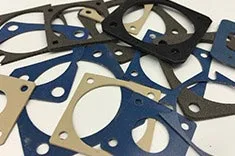EMI Shielding Products
- Custom Gasket Fabrication
- Connector Gaskets
- Bonded O Ring
- Custom Gaskets
- Conduct-O-Knit Knitted Wire Mesh
- Conduct-O-Seal Combo Gasket
- Conduct-O-Elastomer
- Conduct-O-Seal Oriented Wire in Silicone Gasket Material
- Conduct-O-Mesh Tape
- Conduct-O-Foam
- Conduct-O-Bond
- Optical Filters For Electronic Displays
- Shielded Vent Panels
- ESC Board Level Shielding
- 300 Series
Effective EMI Shielding: Materials and Methods
 Electromagnetic interference (EMI) presents a significant challenge in today's industrial and commercial sectors. The demand for reliable shielding solutions is growing as electronics become more sophisticated and are deployed in sensitive environments. Traditional reliance on metal-based materials for EMI shielding remains effective but often comes with weight, cost, and corrosion limitations. However, various materials are now available that offer practical, proven solutions for real-world applications in industries such as telecommunications, automotive, aerospace, and medical devices.
Electromagnetic interference (EMI) presents a significant challenge in today's industrial and commercial sectors. The demand for reliable shielding solutions is growing as electronics become more sophisticated and are deployed in sensitive environments. Traditional reliance on metal-based materials for EMI shielding remains effective but often comes with weight, cost, and corrosion limitations. However, various materials are now available that offer practical, proven solutions for real-world applications in industries such as telecommunications, automotive, aerospace, and medical devices.
Fundamental Principles of EMI Shielding
EMI shielding works by using materials that reflect or absorb electromagnetic waves, preventing interference from disrupting the functioning of electronic devices. Metals like aluminum, copper, and nickel have long been used due to their high conductivity. Still, their practical limitations (e.g., weight and susceptibility to corrosion) drive demand for more versatile options. Shielding effectiveness (SE), a crucial parameter in EMI shielding, quantifies the ability of a material to block electromagnetic waves. It is measured in decibels (dB) and highly depends on frequency, material thickness, and conductivity. A higher SE value indicates better shielding performance.
Proven Materials for EMI Shielding
- Metal Foams and mesh metals: Their versatile forms remain among the most widely used materials for EMI shielding. Metal foams (e.g., aluminum and copper) balance performance and weight reduction, making them ideal for applications where weight is critical. On the other hand, metal meshes create a lightweight, flexible solution that provides sufficient shielding while maintaining airflow or visibility. With their adaptability, these materials are commonly applied in medical equipment housings or ventilation panels where electronic devices must be shielded without trapping heat.
In other cases, metal meshes create a lightweight, flexible solution that provides sufficient shielding while maintaining airflow or visibility. These are commonly applied in medical equipment housings or ventilation panels where electronic devices must be shielded without trapping heat.
- Conductive Polymers: Polymers such as polyaniline (PAn)and polypyrrole (PPY) are gaining popularity because they can be formed into flexible, corrosion-resistant shields. Conductive polymers offer shielding effectiveness between 20-40 dB and are increasingly used in telecommunications and portable electronics, where the demand for lightweight, durable shielding solutions is crucial.
A key benefit of conductive polymers is their ability to be coated onto existing components or fabrics, creating a flexible and protective layer. For example, conductive polymer coatings are often applied in flexible electronic devices, where traditional metal shielding would be impractical due to rigidity.
- Carbon-based: Materials like carbon nanotubes (CNTs) and graphene have also been widely applied in EMI shielding, particularly in industries requiring shielding and thermal management. Carbon-based materials are integrated into polymer composites to enhance their conductivity while keeping weight low. These materials are currently used in environments where heat dissipation is just as important as shielding, such as in high-frequency applications or compact electronic assemblies.
Real-World Applications of EMI Shielding Materials
- Telecommunications Equipment: EMI shielding is critical to maintaining signal integrity in telecommunications. Equipment housings made from aluminum foams or metal-coated polymers are widely used to protect sensitive components from emitted and received interference. With frequency bands continuously expanding, maintaining shielding effectiveness in the gigahertz range requires precise material selection based on specific signal profiles.
- Automotive Electronics: As automobiles increasingly depend on electronic systems for everything from navigation to safety features, ensuring reliable EMI shielding is essential. Aluminum enclosures and carbon-based composites are commonly used to shield electronic control units (ECUs), infotainment systems, and sensor arrays. Shielding in automotive applications must contend with various environmental factors, including temperature extremes, moisture, and vibration, making durable materials like carbon composites highly suitable.
- Medical Devices: In the medical field, ensuring the safety and reliability of electronic devices is paramount. Nickel-plated enclosures and metal-coated fabrics are standard for shielding sensitive diagnostic and therapeutic equipment. The materials used must provide effective EMI shielding and comply with strict regulatory standards for biocompatibility and safety.
- Consumer Electronics: Smartphones, laptops, and wearable devices rely heavily on conductive coatings and lightweight metal meshes to shield their internal components from EMI. These materials allow manufacturers to balance weight and performance while maintaining sleek designs and high levels of functionality.
Practical EMI Shielding Solutions for Today's Applications
Developing advanced materials for EMI shielding has significantly expanded the options available for industries facing EMI challenges. From the lightweight and corrosion-resistant properties of conductive polymers to carbon-based composites' high thermal management capabilities, each material brings distinct advantages depending on the application. As electronics increase, reliable, proven EMI shielding solutions remain critical across sectors, ensuring performance, safety, and compliance in today's demanding environments.



